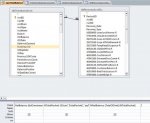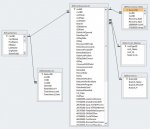Hello,
I'm currently using a Dlookup function to display a calculated field from a query. This works fine when only one record is entered on the many side; however when additional records are entered it doesn't add the additional records. What function/code can I use to add each record's total as it's entered on the many side?
This is what is working when the many side only has one record:
=(DLookUp("[qryTotalBalance]![NetBalance]","[qryTotalBalance]","[CustID]= " & Nz([CustID],0)))
I'm at a loss as to how to go about this...
Thank you for your help in advance.
NLR
I'm currently using a Dlookup function to display a calculated field from a query. This works fine when only one record is entered on the many side; however when additional records are entered it doesn't add the additional records. What function/code can I use to add each record's total as it's entered on the many side?
This is what is working when the many side only has one record:
=(DLookUp("[qryTotalBalance]![NetBalance]","[qryTotalBalance]","[CustID]= " & Nz([CustID],0)))
I'm at a loss as to how to go about this...
Thank you for your help in advance.
NLR




